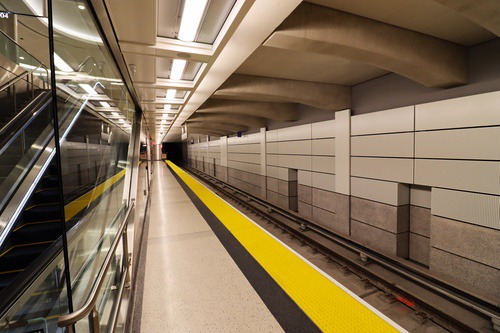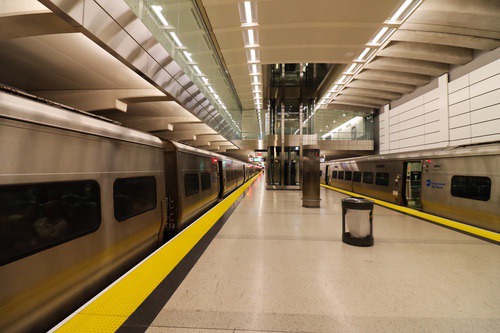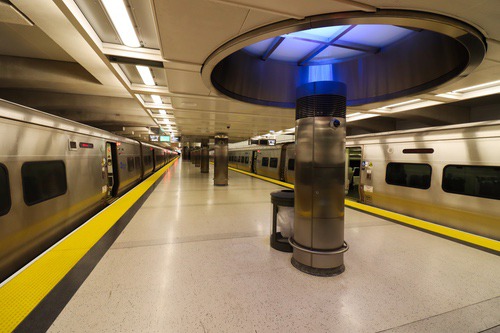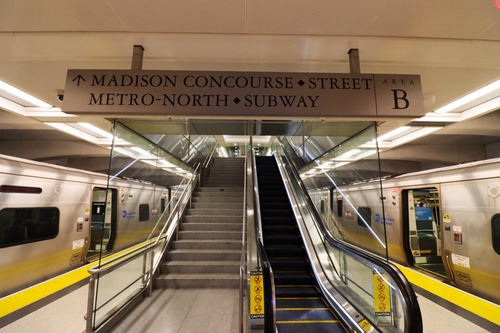

Long Island Rail Road Service into Grand Central Terminal (Madison) began on January 27, 2023 with a soft launch of special “Grand Central Flyer” trains operating every hour to 30 minutes between Grand Central and Jamaica using primarily new M9 trains. Full schedule changes began on February 27, 2003 and is a schedule change I (who as a transit professional) fully say the MTA blotched, and as of Fall 2023 hasn’t recovered from as they keep making tweaks on a schedule that probably should be thrown out and restarted, including reinstating transfers at Jamaica even for the branches that run half-hourly alternating between Grand Central and Penn Station. Like Metro-North at Grand Central there is no service between 2:00am and 5:00am with all overnight LIRR service (which is the only 24 hour railroad in North America) running to and from Penn Station (Atlantic Terminal is also closed then).
The tunnels at Grand Central are too low and two small a loading gauge (particularly the 63 Street tunnels) for C3 BiLevel cars. Even the 100 still running in service older M3s aren’t allowed into Grand Central due to some clearance issues and the slowness of the M9 train delivery order. This results in their being no direct rush-hour dual mode service to and from Grand Central as there is to Penn Station.
The issues for the LIRR now that occurred with the opening of East Side Access are rooted in trying bifurcate relatively infrequent (particularly off-peak) service between two primary terminals instead of one. What hurt this process further is the MTA no longer schedules transfers at Jamaica and doesn’t have trains wait for connections, removing the more than 100 years of “change at Jamaica” pluses, so now trains no longer wait for connections resulting in longer wait times for many commuters. The only J’s that appear on timetables are trains that connect to diesel service on the diesel branches (Oyster Bay, Montauk, and Port Jefferson Branch trains) but only connecting train times to Penn Station and Grand Central, not the other 7 stops in the City Terminal Zone. Passengers going to booming Brooklyn and Atlantic Terminal are now serviced almost entirely by Shuttle trains and West Hempstead Branch trains stopping at a platform that requires using an overpass instead of a cross platform transfer.
Peak Hour service to and from Grand Central is available on all electric branches including the West Hempstead Branch, somewhat frequently. Off-peak and Weekend service to Grand Central is provided by hourly service to/from Grand Central on the four major branches (these now half half-hourly or better service throughout the day with trains alternating service between Grand Central and Penn station): Port Washington Branch, Port Jefferson Branch as far as Huntington, the Ronkonkoma Branch and the Babylon Branch.
From the four more “minor” (I hate putting the Long Beach Branch in this category) electric branches that only receive hourly base service, all off-peak (except overnight) Hempstead Branch service is to and from Grand Central along with weekday Far Rockaway service, and weekend Long Branch service.
This means that service between Grand Central and Jamaica is 5 trains per hour (all trains except Port Washington Branch trains which veer off the mainline at Woodside stop at Jamaica) although the uneven spacing of trains can leave up to 22-minute gaps in service on this important route. Woodside receives 3 trains per hour on weekends, 2 on weekdays from Grand Central, with Forest Hills and Kew Gardens serviced hourly.
These trains all stop at 8 tracks on two different levels with the Lower Mezzanine between them in two different deep-level cavern tubes. To reach the station, two tracks lead through the 63rd Street tunnel from the Herald Interlocking (a short distance before at the same interlocking where the Amtrak’s Hell Gate Line curves off the LIRR main line), as these tracks curve south each track diverges into two separate tracks around about 59th Street (GCT-5 Interlocking, MP 1.09), each set of tracks (from the initial two tracks from the 63 Street tunnel) then become stacked with tracks 1 and 2 leading to the lower level, 3 and 4 to the Upper Level. Just before the station platforms at GCT-3 (Upper Level) GCT-4 (Lower Level) MP 0.69 there is first a diamond crossover that trains use to reverse before or after entering the station to terminate and be on the track for the correct direction of track, before each track separates into two tracks and these tracks become their own respective island platform. There are 4 island platforms each servicing two tracks, for the station, the tracks and tunnels continue south of the station, with each respective platform track’s switching back to becoming one track at GCT-1 and GCT-2 at MP 0.33, before 4 tracks in 2 separate stacked tunnels lead down to MP 0.01 at 38 Street at the end of the East Side Access’s tail tracks.
The platforms themselves, each able to accommodate a 12-car long of 85 foot long cars LIRR train are located in two different deep caverns with the floor of the mezzanine 140 feet below the surface and 91 feet below the bottom of the lower 100 level Metro-North platforms. Each cavern has four tracks on two levels with the Lower Mezzanine. Tracks 201 and 202/301 and 302 share the western cavern, Tracks 203 and 204/303 and 304 share the eastern cavern.
All access to the four platforms is via two separate, full length lower mezzanines, one in each cavern between the two levels of platforms. The entire platform area lacks benches (extremely ableist) with the only seating in a tiny waiting room by the ticket office in the Madison Concourse. These mezzanines are connected by four cross-passageways directly in front of each of the 4 escalator banks that are directly under the 4 cross-streets. These 4 escalator banks to Madison Avenue (plus one set of two elevators) provide all access to the LIRR platforms with everyone having to pass through the western tracks 201/301 and 202/302 cavern. The western cavern has what feels like 4-way intersections by each of these station entrances. These escalator banks are color coded in the following format with the following Arts for Transit Installation opposite the cavern cross-passageways on the walls of the mezzanines for Tracks 203/303 and 204/304:
·48th Street – Cyan
·47th Street – Purple
·46th Street – Blue
·45th Street – Light Green
These colors are used as part of the station’s wayfinding with the escalator bank walls tiled in that color, beacons in that color on the floor of the mezzanine and lights and circular beacons extending with this color up and down to both platform levels in both caverns. The street names are also well labeled throughout the station to help with wayfinding and orientation.
For step free ADA access to leave the station a corridor leads out just south of the 47 Street escalator bank from the western cavern. It’s a good distance before reaching the landing for the two elevators up to the Madison Concourse. There is a shorter passageway at the upper level to an entrance just beyond the station’s waiting room. The single set of elevators in only one location means it’s a mandatory 5 block walk/roll underground for step-free connections between the LIRR and the New York City Subway, 4 blocks to the nearest ADA entrances to the Metro-North platforms). without benches anywhere in the station to pause and take a rest, this is probably the least accessible station to people who can only walk/roll short distances.
The mezzanines each have many staircases and escalators up or down to each platform in their respective cavern. There are two elevators per cavern, one right in front of the separate bank of elevators to exit the station up to the Madison Concourse, and one a bit of a distance further south just south of the 46 Street passageway. These four total elevators each have 3 landings servicing both the upper-level and lower-level platform and Mezzanine in-between. Their separation though (and just a single location for the elevators to leave the station) make ADA riders double-back if they intuitively head south after arriving in the station and their trying to get to main Grand Central Terminal using the southern platform elevator. There is also clearly a freight elevator on each platform.
The two mezzanines become narrower in places running just above one train track below between the 4 escalator banks and cross-passages, this allows views down to the lower platform (Tracks 301/302 or 303/304) below, giving these platforms a double-height ceiling in places. These mezzanines have a single line of quotes running along the opposite wall. Otherwise, the lower-level platforms have flat track walls with different tones of grey concrete-marble looking walls, that extends to cream colored ceiling finishes beneath the mezzanine above. Circular silver 8-foot-high columns (with ventilation at the top of them) line each of the lower-level platforms.
The upper-level platforms (tracks 201-204) feel different than the lower-level ones and subtilty different architecture. The upper-level platform has arched ceilings, curved platform walls and similar faux marble finishes, the roofs are curved and there are no columns (except for beacons the full platform height beneath the four cross streets to help with wayfinding). They have the benefit of all staircases/escalators going down not up, making the platforms feel more spacious without the interruption of staircases going into the ceiling, and no circular beams required.
Photos: 1-61: September 3, 2023; 62-71: September 5, 2023;
Arts For Transit at Grand Central Madison
The Presence; The Spring; The Sound; The Water's Way, 2022
Glass mosaic
By Kiki Smith



